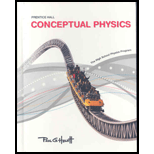
Concept explainers
(a)
The current drawn by the night light.
(a)
Answer to Problem 56A
The current drawn by the night light bulb is
Explanation of Solution
Given info:
Power of the night light bulb,
Supply voltage for the night light bulb,
Formula Used:
Write the expression to calculate the current drawn by the night light bulb.
Calculation:
Substitute given values in the above expression.
Conclusion:
The current drawn by the night light bulb is
(b)
The resistance of the nightlight filament.
(b)
Answer to Problem 56A
The resistance of the night light bulb is
Explanation of Solution
Given info:
Current drawn by the night light bulb is
Supply voltage for the night light bulb is,
Formula Used:
Write the expression to calculate the resistance of the filament.
Calculation:
Substitute given values in the above expression.
Conclusion:
The resistance of the night light bulb is
(c)
The energy uses by the night light in one month.
(c)
Answer to Problem 56A
The energy used by the night light in one month is
Explanation of Solution
Given info:
Power of the night light bulb,
Number of days,
Formula Used:
Write the expression to calculate the energy used by the night light.
Calculation:
Substitute values in the above expression.
Conclusion:
The energy used by the night light in one month is
(d)
The cost of operation for the month.
(d)
Answer to Problem 56A
The cost of operation of night light in a month is
Explanation of Solution
Given info:
Utility rate of the electricity,
Formula Used:
Write the expression to calculate the cost of operation.
Calculation:
Substitute values in the above expression.
Conclusion:
The cost of operation of night light in a month is
Chapter 35 Solutions
Conceptual Physics: The High School Physics Program
Additional Science Textbook Solutions
Human Anatomy & Physiology (2nd Edition)
Microbiology with Diseases by Body System (5th Edition)
Introductory Chemistry (6th Edition)
Microbiology: An Introduction
Microbiology: An Introduction
Anatomy & Physiology (6th Edition)
- Hi! I need help with these calculations for part i and part k for a physics Diffraction Lab. We used a slit width 0.4 mm to measure our pattern.arrow_forwardExamine the data and % error values in Data Table 3 where the angular displacement of the simple pendulum decreased but the mass of the pendulum bob and the length of the pendulum remained constant. Describe whether or not your data shows that the period of the pendulum depends on the angular displacement of the pendulum bob, to within a reasonable percent error.arrow_forwardIn addition to the anyalysis of the graph, show mathematically that the slope of that line is 2π/√g . Using the slope of your line calculate the value of g and compare it to 9.8.arrow_forward
- An object is placed 24.1 cm to the left of a diverging lens (f = -6.51 cm). A concave mirror (f= 14.8 cm) is placed 30.2 cm to the right of the lens to form an image of the first image formed by the lens. Find the final image distance, measured relative to the mirror. (b) Is the final image real or virtual? (c) Is the final image upright or inverted with respect to the original object?arrow_forwardConcept Simulation 26.4 provides the option of exploring the ray diagram that applies to this problem. The distance between an object and its image formed by a diverging lens is 5.90 cm. The focal length of the lens is -2.60 cm. Find (a) the image distance and (b) the object distance.arrow_forwardPls help ASAParrow_forward
 College PhysicsPhysicsISBN:9781305952300Author:Raymond A. Serway, Chris VuillePublisher:Cengage Learning
College PhysicsPhysicsISBN:9781305952300Author:Raymond A. Serway, Chris VuillePublisher:Cengage Learning University Physics (14th Edition)PhysicsISBN:9780133969290Author:Hugh D. Young, Roger A. FreedmanPublisher:PEARSON
University Physics (14th Edition)PhysicsISBN:9780133969290Author:Hugh D. Young, Roger A. FreedmanPublisher:PEARSON Introduction To Quantum MechanicsPhysicsISBN:9781107189638Author:Griffiths, David J., Schroeter, Darrell F.Publisher:Cambridge University Press
Introduction To Quantum MechanicsPhysicsISBN:9781107189638Author:Griffiths, David J., Schroeter, Darrell F.Publisher:Cambridge University Press Physics for Scientists and EngineersPhysicsISBN:9781337553278Author:Raymond A. Serway, John W. JewettPublisher:Cengage Learning
Physics for Scientists and EngineersPhysicsISBN:9781337553278Author:Raymond A. Serway, John W. JewettPublisher:Cengage Learning Lecture- Tutorials for Introductory AstronomyPhysicsISBN:9780321820464Author:Edward E. Prather, Tim P. Slater, Jeff P. Adams, Gina BrissendenPublisher:Addison-Wesley
Lecture- Tutorials for Introductory AstronomyPhysicsISBN:9780321820464Author:Edward E. Prather, Tim P. Slater, Jeff P. Adams, Gina BrissendenPublisher:Addison-Wesley College Physics: A Strategic Approach (4th Editio...PhysicsISBN:9780134609034Author:Randall D. Knight (Professor Emeritus), Brian Jones, Stuart FieldPublisher:PEARSON
College Physics: A Strategic Approach (4th Editio...PhysicsISBN:9780134609034Author:Randall D. Knight (Professor Emeritus), Brian Jones, Stuart FieldPublisher:PEARSON





